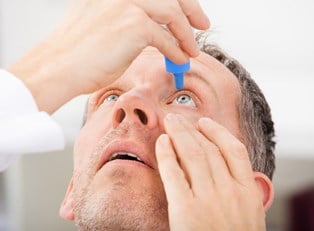Chronic dry eyes are no laughing matter. Dry eyes are a common, painful condition that can affect as much as 30% of the population. This condition makes eyes feel tired and look red all of the time. When someone's eyes feel tired, it can make the rest of the body feel tired, too.
Besides feeling tired, other symptoms of dry eyes include: burning, stinging, sensitivity, blurred vision, double vision, and matted eyes. All of these symptoms cause discomfort and negatively impact the quality of someone's life.
Common Causes
There are many things that can cause dry eyes. First, dry eyes can occur at any age. However, older people produce fewer tears. This makes older adults more prone to dry eyes.
Second, environmental factors can contribute to dryness. If the air at work, outside, or at home is dry, this can cause eye irritation. If dry air is the culprit, run a humidifier and see if this takes care of the problem.
Third, dry eyes can occur in people who wear contact lenses. This is especially true for people who wear soft contact lenses. Soft lenses have a tendency to absorb any wetness in the eye. As a result soft lenses can leave eyes dry and uncomfortable. If this is a problem, contact your optometrist who may prescribe a different type of contact lens in order to eliminate this issue.
Fourth, if you have allergies, antihistamines can cause dry eyes. Likewise, if you have a cold, decongestants can contribute to dryness. Other medications such as antidepressants, birth control, sleeping pills, diuretics, and pain killers can all contribute to dry eyes as well.
Lastly, some physical conditions can also cause dry eyes. Common illnesses that lead to dry eyes includes: diabetes, rheumatoid arthritis, lupus, shingles, Bell’s Palsy, scleroderma, Sjogren’s Syndrome, Vitamin A deficiency, refractive eye surgeries, and menopause.
Treatment Options
For treatment of this condition, there are some over-the-counter eye drops that offer relief from the pain and itchiness that dry eyes cause. Nutrition can also help to reduce dry eyes. A diet that contains omega-3 fatty acids can help prevent dryness of the eyes. Food that contains omega-3 includes: salmon, tuna, sardines, trout, herring, olive oil, canola oil, flax oil, hemp seed, pumpkin seeds, soybeans, flax seed, cauliflower, tofu, and walnuts.
If over the counter eye drops do not alleviate dry eye symptoms, it is important to be evaluated by an optometrist. These eye specialists can prescribe prescription eye drops to help relieve the painful symptoms of dry eyes. Restasis is a common prescription for chronic dry eyes. These prescription drops can offer relief by increasing the eyes process of tear production. Restasis also helps reduce the inflammation that causes discomfort and redness.
Dry eyes are a common problem. Sometimes dry eyes can be treated with over-the-counter remedies. Other times, it requires prescription treatment. Either way, treatment is available to offer relief from an uncomfortable eye problem.



